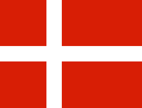Dictionary of Vexillology: D (Daimyo Flags – Dentelé) (original) (raw)
DAIMYO FLAGS (or DAIMO FLAGS)
Generically, a term for those flags that were in use prior to the Japanese Imperial restoration of 1868/71 – a nobori, hata-sashimono / sashimono and/or uma-jirushi – but see notes below (also (also ‘hinomaru’ and ‘mon’)
Specifically, a term that refers to the personal and war flags of Japanese feudal lords, and in use until the 17th century.

16th/17thc. Daimyo flags
Notes a) With regard to 1), the varying types of (historical) Japanese flag are in the process of detailed classification, and the terms given above have been limited to those in general use. b) The�sashimono” and “uma-jirushi”, whilst currently employed to describe flags, can also refer to a vexilloid – see ‘vexilloid 2)’.
DANCETTY (or DANCETTÉ)
The alternative heraldic terms used when an ordinary such as a fess, bend or pale, or the line of a division, or a border on a shield, banner of arms or flag, is saw-toothed – dancetté, dentelé or dentilly – but see ‘indented’ and ‘serrated’ (also ‘ordinary’, ‘stepped’ and ‘wolfteeth’).



Flag of Poiares e Canelas, Portugal; Flag of Nazaré, Portugal; Flag of Darscheid, Germany
DANGER FLAG
See ‘red flag 1)’.
DANNEBROG
Literally “Danish-cloth”, and the national flag of Denmark (see also ‘splittflag’).
DE FACTO
1. (adj) A generally employed Latin term for in practice, and used in vexillology to indicate flags in actual use as opposed to those as laid down by law or regulation – see de jure.
2. (adj) A term sometimes employed to describe a flag which is in use, but which has not been officially established by law or regulation – but see the note below (also unofficial flag).


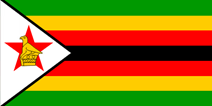

The Reverse of the National Flag of Saudi Arabia in some De Facto use, and as regulated ; National Flag of Zimbabwe in some De Facto use, and as regulated.
Please note with regard to 2), it is suggested that the above term should not be used when describing a flag for which no known official specifications exist, therefore, no de jure design from which a de facto flag may differ, and under these circumstances we recommend that the term "variant" be employed – see variant 2).
DE JURE
(adj) A generally employed Latin term for ‘in law’, and used in vexillology to indicate a flag as laid down by law or regulation, as opposed to those in actual use – see de facto 1) (also flag law, official flag 1), specification sheet, and the notes below).

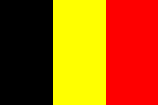
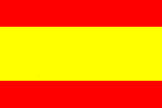

National Flag of Belgium as regulated, plus the Civil Ensign of Belgium as laid down by law (which is also the de facto National Flag); National Flag of Spain as established by Law, and the State Flag as regulated for official use but flown as a National Flag by Private Citizens.
Please note that a further example of de jure as opposed to de facto is the proportions of the Vatican City flag which is set at 1:1 by law, but which is always seen in practice with proportions of 2:3.
DEBASED
An alternative heraldic term to "reversed", see reversed 2).



Example; Flag and Arms of Rennebu, Norway
DEBRUISED
A heraldic term used in place of ‘surmounted by’ particularly when a charge or ordinary (which may or may not touch the field) is being placed over an animal – but see ‘surmounted, by’ (also ‘charge 2)’, ‘ensigned’, ‘ordinary’ and ‘overall 2)’).
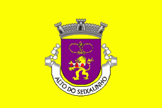

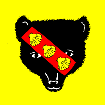
Flag of Alto do Seixalinho, Portugal; Flag of Grafton, Australia; Flag of L'Abbaye, Switzerland
DECK FLAGS
A term to describe the practice, now obsolete, of showing a display of flags along the deck of a ship as illustrated below – see ‘pavisade’ and ‘streamer 2)’ (also ‘ancient’ and ‘postures’).

The Salamander, English Royal Navy c1525 (Wikipedia)
Please note, that these flags (and their staffs) were intended to have a double purpose, in that they could be displayed aboard ship in times of celebration and carried (by hand) during any operations ashore
DECKING
A term for the custom of foot guards in British and Canadian service of placing a garland or chaplet of laurel – a crown triumphal – at the top of the regimental colour pike or staff on days of significance in regimental history (see also ‘colour 2), ‘colours 2)’, ‘crown triumphal’, ‘garland’, ‘pike’, ‘staff 2)’ and ‘wreath of immortelles’).
DECOMMISSIONING PENNANT
See ‘paying off pennant’.
DECORATED
In heraldry see ‘garnished’.
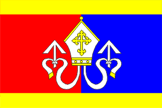

Flag and Arms of Častrov, Czechia
DECORATIVE KNOT
See wattle(d) 1), sword knot and the note below.

Flag of Staffordshire, UK
Please note that the several types of decorative knot used in heraldry are rarely seen on flags, so are beyond the remit of this dictionary, and we suggest that a suitable source be consulted if further details are required.
DECRESCENT (or DECREMENT)
In heraldry see ‘moon 2)’ with following note.
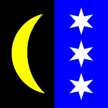
Flag of Schinznach Dorf, Switzerland
DEFACE
1. (v) In UK usage and some others, a term for the addition of any authorised (or apparently authorized) emblem, badge, shield, charge or device to a flag (see also badge, charge, defaced, device, emblem,shield, template flag andundefaced).
2. (v) In US usage and some others, the term may also be used to include any unauthorized addition – but see note below.
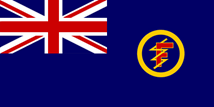
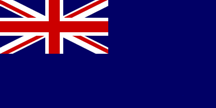
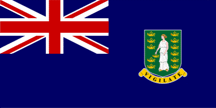
Ensign of the Training Ship Foudroyant c1817–1897; Reserve Ensign, UK; Flag of the British Virgin Islands
Please note that in heraldry and vexillology the term has no pejorative connotation – see desecrate and disfigure.
DEFACED
(adj) In UK usage and in some others the term used to describe a flag which is often flown plain, but in this case is seen with an authorized addition – see undefaced (also blue ensign, deface 1), red ensign, template flag and warrant).
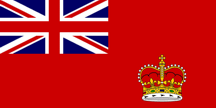
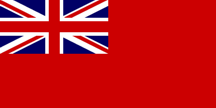
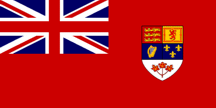
Ensign of the Royal St George Yacht Club, UK;Civil Ensign, UK;Canadian Red Ensign 1957–1965
DEFENCE (or DEFENDED)
The heraldic terms that refer to the tusks of a boar or of an elephant.



Flag of Pleşeni, Moldova; National Arms of Botswana; Flag of Hilfikon, Switzerland
DEMI (or DEMY)
The heraldic term used when the front or upper part of an animal, or one-half of another charge is shown on a shield, banner of arms or a flag but see the notes below – demy or semi (also demi-vol).
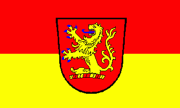
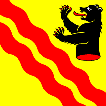
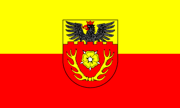
Flag of Langenhagen, Germany; Flag of Romoos, Switzerland; Flag of Hildesheim, Germany
Notes a) One-half of an animal or other charge that is placed against the vertical centre line of a shield, banner of arms or a flag, is said to be dimidiated, whilst any such emerging from side of a shield, banner of arms or flag should be termed naissant as illustrated below. b) However, this last is never used alone, but always with the charge being so described – for example a demi-calf naissant as shown below.


Flag of Krásné Pole, Czechia; Flag of Kalbe upon Milde, Germany
DEMI-VOL
The heraldic term that should used for the single wing of a bird rather than a pair of wings together – see vol and volant with its following note (also "demi" [above]).



Flag of Šenkovec, Croatia; Flag of Luins, Switzerland; Flag of Porta Westfalica City, Germany
DEMONSTRATION BANNER
See banner 3).
DENTELÉ (or DENTILLY)
Alternative heraldic terms for dancetty – see dancetty (also serrated).

Flag of Brugelette, Belgium

